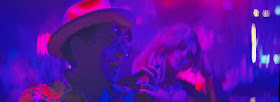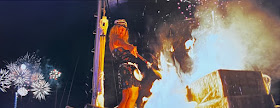From the rue Daguerre to Show World
Pier Paolo Pasolini alights around Times Square, immediately struck by the poverty of Manhattan — and this before the 2020s — all things relative. The film is assembled from the newly discovered, in 2021 (hence the non-inclusion in Criterion's The Complete Agnès Varda set), handheld footage that Varda shot in 1967 during a stopover in New York by the Italian filmmaker and poet. "He calls this poverty? I've seen the arid lots of Accattone and Mamma Roma," some American viewers might once have bristled. A Middle Easterner looked at us clearly during the catastrophic response to Hurricane Katrina, and sees us again with the housing displacement and tent cities of the modern age and remarks, How sad they live, in the greatest nation on earth.
The aptly titled Pier Paolo Pasolini - Agnès Varda - New York - 1967 considers the era and world of Colson Whitehead's trilogy-in-progress of novels (the first two parts being the recent Harlem Shuffle and Crook Manifesto) and shuttles the arrivals at relief. Pasolini's got a return ticket in his pocket. •
===
The film is available to watch here, with English subtitles, at the Cinémathèque Française's essential streaming platform Henri, where it premiered and, at present, resides exclusively from late-2023. An accompanying note by Agnès's daughter Rosalie Varda reads (my translation now, from the French) —
===
During the pandemic, we were cleaning things up at the little family enterprise Ciné-Tamaris. In the cellar of the office we found boxes of celluloid, of 35mm, of 16mm, of reels of Super 8. There were two boxes of 16mm rather enigmatically labeled: "PASOLINI NEW YORK." When I opened it up, I found two double-track reels of 16mm. Unspooling this film, I come across Pasolini's face.
Obviously this is a huge surprise! Agnès always used to say, "Oh là là, there's still some tidying to be done! You'll get around to it later." So it got taken care of: the reels were immediately sent to the Éclair Classics / Immagine Ritrovata lab, place de Clichy, and, to the surprise of all, we discovered that Agnès had done some filming in New York with a 16mm camera.
The second surprise was that actually Agnès had edited the images an audio interview that she made later with Pasolini. We carried out the investigation. Pasolini and Agnès were together in 1966 at the New York Film Festival. They already knew one another. Why didn't she complete the editing of this interview? The mystery shall remain intact.
What's extraordinary about this little treasure is that Agnès, always full of force, poses simple and precise questions, and that Pasolini who is nevertheless very complicated, responds to her questions just as simply. It's what makes the originality of this work: two friends in discussion. — Rosalie Varda •
===
Other writing on Agnès Varda at Cinemasparagus:
La Pointe-Courte [1955]
Ô saisons ô châteaux [O Seasons, O Châteaux, 1957]
L'Opéra-Mouffe, carnet de notes filmées rue Mouffetard par une femme enceinte en 1958 [The Opéra-Mouffe: Diary Filmed on the rue Mouffetard in Paris by a Pregnant Woman in 1958, 1958]
Du côté de la Côte [Around the Côte, 1958]
Les fiancés du pont Mac Donald, ou (Méfiez-vous des lunettes noires) [The Fiancés of the Pont Mac Donald, or: (Beware of Dark Glasses), 1961]
Cléo de 5 à 7 [Cléo from 5 to 7, 1962]
Le bonheur [Happiness, 1964]
Elsa la Rose [Elsa the Rose, 1966]
Les créatures [The Creatures, 1966]
Pier Paolo Pasolini - Agnès Varda - New York - 1967 [1967, posthumous release 2023]
Uncle Yanco [1967]
Black Panthers [1968]
Lions Love... and Lies / Lions Love [1969]
Nausicaa [1970]
Réponse de femmes à une question produite par Antenne 2 pour le magazine 'F. comme Femme' [Women's Response to a Question Put Forth by Antenne 2 for the Magazine-Show 'F. comme Femme', 1975]
Daguerréotypes [1976]
Plaisir d'amour en Iran [Giddiness of Love in Iran] [1976]
L'une chante l'autre pas [The One Sings the Other Doesn't] [1977]
Mur murs [1980]
Documenteur: An Emotion Picture [1981]
===











































































